Seed Pelleting with Gum Arabic-Encapsulated Biocontrol Bacteria for Effective Control of Clubroot Disease in Pak Choi
Abstract
:1. Introduction
2. Materials and Methods
2.1. Material and Bacterial Strain
2.2. Bacterial Strains and Culture Conditions
2.3. Preparation of P. polymyxa ZF129 Microcapsules by Spray-Drying
2.4. Preparation of P. polymyxa ZF129 Pelleted Seed (ZF129 Seed) and P. polymyxa ZF129 Microcapsule Pelleted Seeds (ZF129m Seed)
2.5. Field Emission Scanning Electron Microscopy (FESEM)
2.6. Dynamic Laser Scattering
2.7. Determination of Moisture Content
- a = weight of an empty dish;
- b = weights of dish and wet powder;
- c = weights of dish and dried powder.
2.8. Encapsulation Efficiency of P. polymyxa ZF129 Microcapsules
2.9. Storage Stability of P. polymyxa ZF129 Microcapsule Powder and P. polymyxa ZF129 Pelleted Seeds
2.10. Release Behavior of P. polymyxa ZF129 Cells from Pelleted Seeds
2.11. Efficiency of P. polymyxa ZF129 Microcapsule Pellet Seed against Clubroot on Pak Choi
2.12. Statistical Analysis
3. Results and Discussion
3.1. Morphology of Microcapsules
3.2. Filler Formula Screening for Seed Pelleting
3.3. Encapsulation of P. polymyxa ZF129 by the Spray Drying Method
3.4. Particle Size Analysis
3.5. Viability of the Encapsulated ZF129 during Storage
3.6. The Release Behavior of ZF129 from the Composite Capsules
3.7. Loading of ZF129 in Pelleted Seeds
3.8. Viable Cell Count in ZF129 Microcapsule-Loaded Seed during Storage
3.9. Control Effect of Pak Choi Clubroot Diseases by ZF129m Seed Pelleting in the Greenhouse
4. Conclusions
Author Contributions
Funding
Data Availability Statement
Acknowledgments
Conflicts of Interest
References
- McDonald, M.R.; Sharma, K.; Gossen, B.D.; Deora, A.; Feng, J.; Hwang, S.-F. The role of primary and secondary infection in host response to Plasmodiophora brassicae. Phytopathology 2014, 104, 1078–1087. [Google Scholar] [CrossRef]
- Wang, X.; Wang, H.; Wang, J.; Sun, R.; Wu, J.; Liu, S.; Bai, Y.; Mun, J.H.; Bancroft, I.; Cheng, F.; et al. The genome of the mesopolyploid crop species Brassica rapa. Nat. Genet. 2011, 43, 1035–1039. [Google Scholar] [CrossRef]
- Wallenhammar, A.-C.; Wallenhammar, A. Prevalence of Plasmodiophora brassicae in a spring oilseed rape growing area in central Sweden and factors influencing soil infestation levels. Plant Pathol. 1996, 45, 710–719. [Google Scholar] [CrossRef]
- Narisawa, K.; Tokumasu, S.; Hashiba, T. Suppression of clubroot formation in Chinese cabbage by the root endophytic fungus, Heteroconium chaetospira. Plant Pathol. 1998, 47, 206–210. [Google Scholar] [CrossRef]
- Arie, T.; Kobayashi, Y.; Kono, Y.; Gen, O.; Yamaguchi, I. Control of clubroot of crucifers by Phoma glomerata and its product epoxydon. Pestic. Sci. 1999, 55, 602–604. [Google Scholar] [CrossRef]
- Joo, G.J.; Kim, Y.M.; Kim, J.W.; Kim, W.C.; Rhee, I.K.; Choi, Y.H. Biocontrol of cabbage clubroot by the organic fertilizer using Streptomyces sp. AC-3. Korean J. Microbiol. Biotechnol. 2004, 32, 172–178. [Google Scholar]
- Arie, T.; Kobayashi, Y.; Okada, G.; Kono, Y.; Yamaguchi, I. Yamaguchi Control of soilborne clubroot disease of cruciferous plants by epoxydon from Phoma glomerata. Plant Pathol. 1998, 47, 743–748. [Google Scholar] [CrossRef]
- Kim, S.; Shin, C.; Moon, S.; Yi, Y.; Lim, Y. Isolation and characterization of Streptomyces sp. KACC 91027 against Plasmodiophora brassicae. J. Microbiol. Biotechnol. 2004, 14, 220–223. [Google Scholar]
- Hashiba, T.; Morita, S.; Narisawa, K.; Usuki, K. Mechanisms of symbiosis and disease suppression of root endophytic fungus. J. Agri. Chem. Soc. 2003, 77, 130–133. [Google Scholar]
- Usuki, F.; Narisawa, K.A. Mutualistic symbiosis between a dark septate endophytic fungus, Heteroconium chaetospira, and a non-mycorrhizal plant, Chinese cabbage. Mycologia 2007, 99, 175–184. [Google Scholar] [CrossRef]
- Morita, S.; Azuma, M.; Aoba, T.; Satou, H.; Narisawa, K.; Hashiba, T. Induced systemic resistance of Chinese cabbage to bacterial leaf spot and Alternaria leaf spot by the root endophytic fungus, Heteroconium chaetospira. J. Gen. Plant Pathol. 2003, 69, 71–75. [Google Scholar] [CrossRef]
- Li, L.; Zhao, Y.R.; Zheng, F.; Shi, Y.X.; Chai, A.L.; Xie, X.W.; Li, B.J. Screening and control effect of biocontrol bacteria on potato black scurf. Acta Phytopathol. Sin. 2021, 51, 294–297. [Google Scholar]
- Ehsanfar, S.; Modarres-Sanavy, S.A. Crop protection by seed coating. Commun. Agric. Appl. Biol. Sci. 2005, 70, 225–229. [Google Scholar] [PubMed]
- O’callaghan, M. Microbial inoculation of seed for improved crop performance: Issues and opportunities. Appl. Microbiol. Biotechnol. 2016, 100, 5729–5746. [Google Scholar] [CrossRef] [PubMed]
- Jetiyanon, K.; Wittaya-Areekul, S.; Plianbangchang, P. Film coating of seeds with Bacillus cereus RS87 spores for early plant growth enhancement. Can. J. Microbiol. 2008, 54, 861–867. [Google Scholar] [CrossRef]
- Oliveira, R.S.; Rocha, I.; Ma, Y.; Vosátka, M.; Freitas, H. Seed coating with arbuscular mycorrhizal fungi as an ecotechnological approach for sustainable agricultural production of common wheat (Triticum aestivum L.). J. Toxicol. Environ. Health Part A 2016, 79, 329–337. [Google Scholar] [CrossRef]
- Rouphael, Y.; Colla, G.; Graziani, G.; Ritieni, A.; Cardarelli, M.; De Pascale, S. Phenolic composition, antioxidant activity and mineral profile in two seed-propagated artichoke cultivars as affected by microbial inoculants and planting time. Food Chem. 2017, 234, 10–19. [Google Scholar] [CrossRef]
- Accinelli, C.; Abbas, H.K.; Little, N.S.; Kotowicz, J.K.; Shier, W.T. Biological control of aflatoxin production in corn using non-aflatoxigenic Aspergillus flavus administered as a bioplastic-based seed coating. Crop. Prot. 2018, 107, 87–92. [Google Scholar] [CrossRef]
- Accinelli, C.; Abbas, H.K.; Shier, W.T. A bioplastic-based seed coating improves seedling growth and reduces production of coated seed dust. J. Crop. Improv. 2018, 32, 318–330. [Google Scholar] [CrossRef]
- Rocha, I.; Ma, Y.; Carvalho, M.F.; Magalhaes, C.; Janouskova, M.; Vosatka, M.; Freitas, H.; Oliveira, R.S. Seed coating with inocula of arbuscular mycorrhizal fungi and plant growth promoting rhizobacteria for nutritional enhancement of maize under different fertilization regimes. Arch. Agron. Soil. Sci. 2019, 65, 31–43. [Google Scholar] [CrossRef]
- Rocha, I.; Ma, Y.; Vosátka, M.; Freitas, H.; Oliveira, R.S. Growth and nutrition of cowpea (Vigna unguiculata) under water deficit as influenced by microbial inoculation via seed coating. J. Agron. Crop. Sci. 2019, 205, 447–459. [Google Scholar] [CrossRef]
- Rocha, I.; Ma, Y.; Souza-Alonso, P.; Vosátka, M.; Freitas, H.; Oliveira, R.S. Seed Coating: A tool for delivering beneficial microbes to agricultural crops. Front. Plant Sci. 2019, 10, 1357. [Google Scholar] [CrossRef]
- Estevinho, B.M.; Rocha, F.A.; Santos, L.M.; Alves, M.A.C. Using water-soluble chitosan for flavour microencapsulation in food industry. J. Microencapsul. 2013, 30, 571–579. [Google Scholar] [CrossRef]
- Liu, H.; Gong, J.; Chabot, D.; Miller, S.S.; Cui, S.W.; Ma, J.G.; Zhong, F.; Wang, Q. Protection of heat-sensitive probiotic bacteria during spray-drying by sodium caseinate stabilized fat particles. Food Hydrocoll. 2015, 51, 459–467. [Google Scholar] [CrossRef]
- Cortés-Rojas, D.; Beltrán-Acosta, C.; Zapata-Narvaez, Y.; Chaparro, M.; Gómez, M.; Cruz-Barrera, M. Seed coating as a delivery system for the endophyte Trichoderma koningiopsis Th003 in rice (Oryza sativa). Appl. Microbiol. Biotechnol. 2021, 105, 1889–1904. [Google Scholar] [CrossRef]
- Liebeke, M.; Brözel, V.S.; Hecker, M.; Lalk, M. Chemical characterization of soil extract as growth media for the ecophysiological study of bacteria. Appl. Microbiol. Biotechnol. 2009, 83, 161–173. [Google Scholar] [CrossRef]
- Peng, G.; McGregor, L.; Lahlali, R.; Gossen, B.D.; Hwang, S.F.; Adhikari, K.K.; Strelkov, S.E.; McDonald, M.R. Potential biological control of clubroot on canola and crucifer vegetable crops. Plant Pathol. 2011, 60, 566–574. [Google Scholar] [CrossRef]
- Lahlali, R.; Peng, G.; Gossen, B.D.; McGregor, L.; Yu, F.Q.; Hynes, R.K.; Hwang, S.F.; McDonald, M.R.; Boyetchko, S.M. Evidence that the biofungicide serenade (Bacillus subtilis) suppresses clubroot on canola via antibiosis and induced host resistance. Phytopathology 2013, 103, 245–254. [Google Scholar] [CrossRef] [PubMed]
- Freitas, S.; Merkle, H.P.; Gander, B. Microencapsulation by solvent extraction/evaporation: Reviewing the state of the art of microsphere preparation process technology. J. Control. Release 2005, 102, 313–332. [Google Scholar] [CrossRef]
- Goswami, S.; Naik, S. Natural gums and its pharmaceutical application. J. Sci. Innovative. Res. 2014, 3, 112–121. [Google Scholar] [CrossRef]
- Liu, Z.; Wei, H.; Li, Y.; Li, S.; Luo, Y.; Zhang, D.; Ni, L. Optimization of the spray drying of a Paenibacillus polymyxa-based biopesticide on pilot plant and production scales. Biocontrol Sci. Technol. 2014, 24, 426–435. [Google Scholar] [CrossRef]
- Keswani, C.; Bisen, K.; Singh, V.; Sarma, B.K.; Singh, H.B. Formulation technology of biocontrol agents: Present status and future prospects. In Bioformulations: Sustainable Agriculture; Springer: Berlin/Heidelberg, Germany, 2016; pp. 35–52. [Google Scholar]
- Desmond, C.; Ross, R.P.; O’Callaghan, E.; Fitzgerald, G.; Stanton, C. Improved survival of Lactobacillus paracasei NFBC 338 in spray-dried powders containing gum acacia. J. Appl. Microbiol. 2002, 93, 1003–1011. [Google Scholar] [CrossRef] [PubMed]
- Würth, R.; Foerst, P.; Kulozik, U. Effects of skim milk concentrate dry matter and spray drying air temperature on formation of capsules with varying particle size and the survival microbial cultures in a microcapsule matrix. Dry. Technol. 2018, 36, 93–99. [Google Scholar] [CrossRef]
- Ferdousi, R.; Rouhi, M.; Mohammadi, R.; Mortazavian, A.M.; Khosravi-Darani, K.; Rad, A.H. Evaluation of probiotic survivability in yogurt exposed to cold chain interruption. Iran. J. Pharm. Res. IJPR 2013, 12, 139–144. [Google Scholar] [PubMed]
- Fu, N.; Chen, X.D. Towards a maximal cell survival in convective thermal drying processes. Food Res. Int. 2011, 44, 1127–1149. [Google Scholar] [CrossRef]
- Arepally, D.; Reddy, R.S.; Goswami, T.K. Encapsulation of Lactobacillus acidophilus NCDC 016 cells by spray drying: Characterization, survival after in vitro digestion, and storage stability. Food. Func. 2020, 11, 8694–8706. [Google Scholar] [CrossRef] [PubMed]
- Li, J.-Y.; Gao, T.-T.; Wang, Q. Comparative and functional analyses of two sequenced Paenibacillus polymyxa genomes provides insights into their potential genes related to plant growth-promoting features and biocontrol mechanisms. Front. Genet. 2020, 11, 564939. [Google Scholar] [CrossRef]
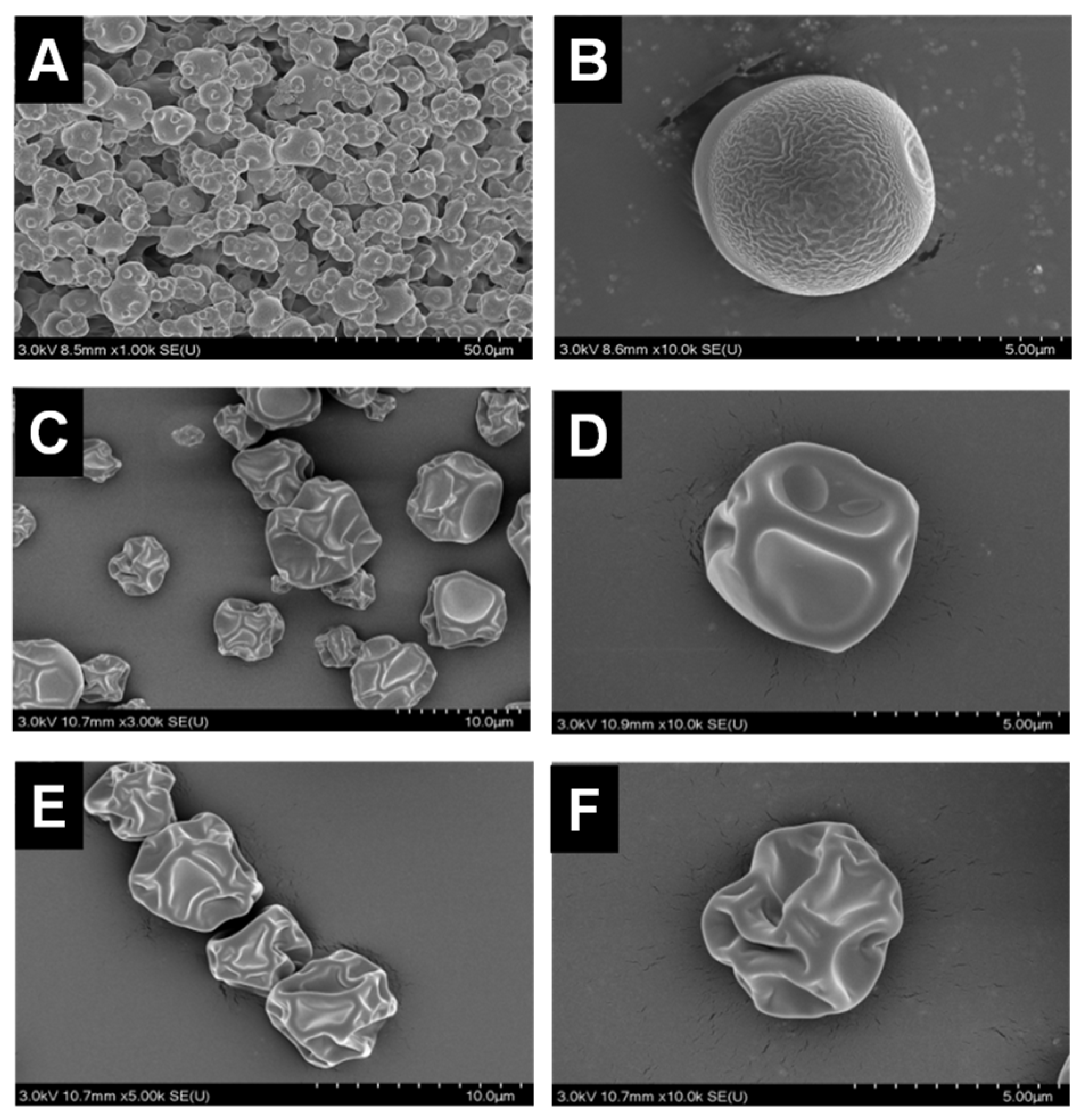



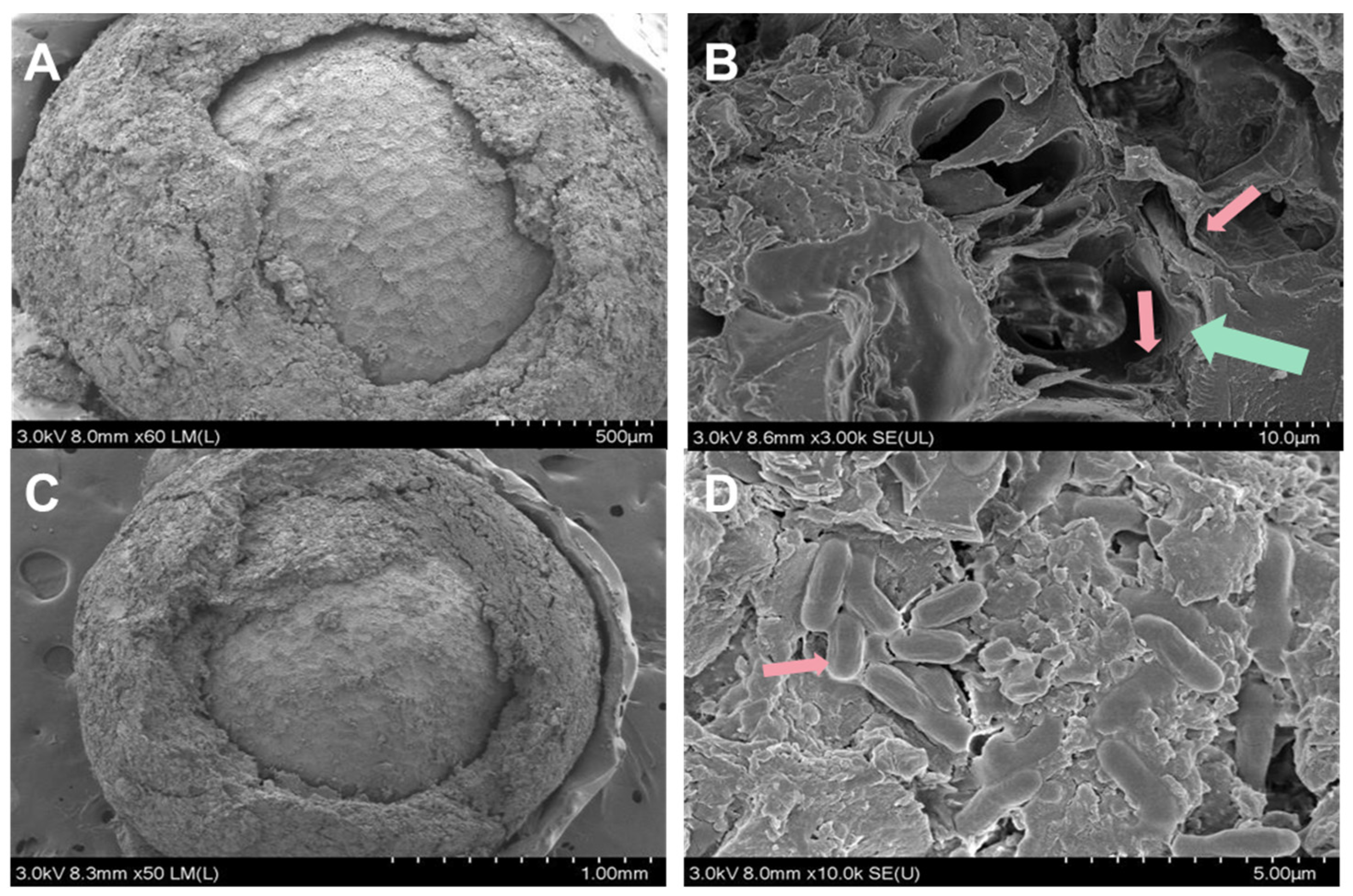
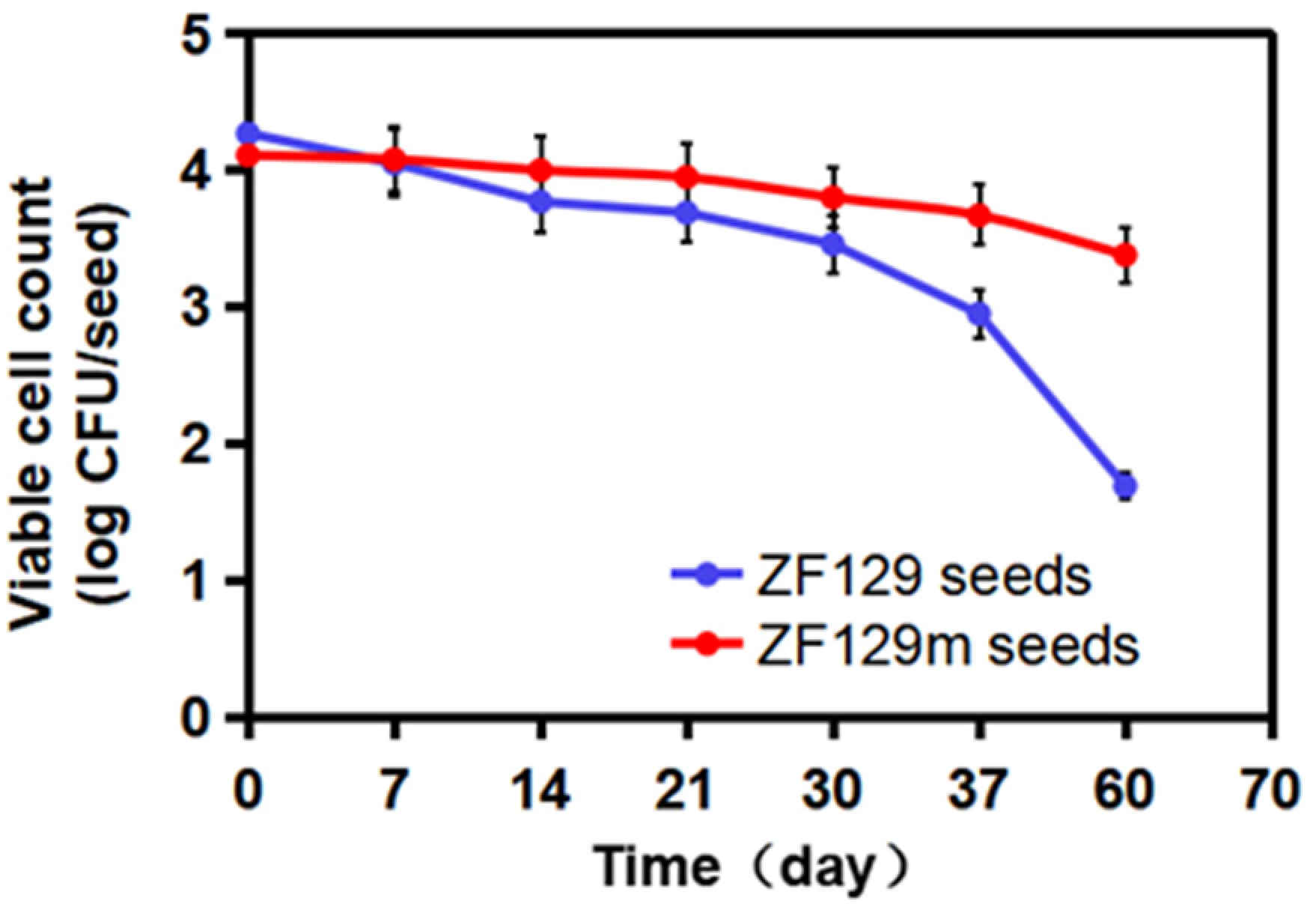
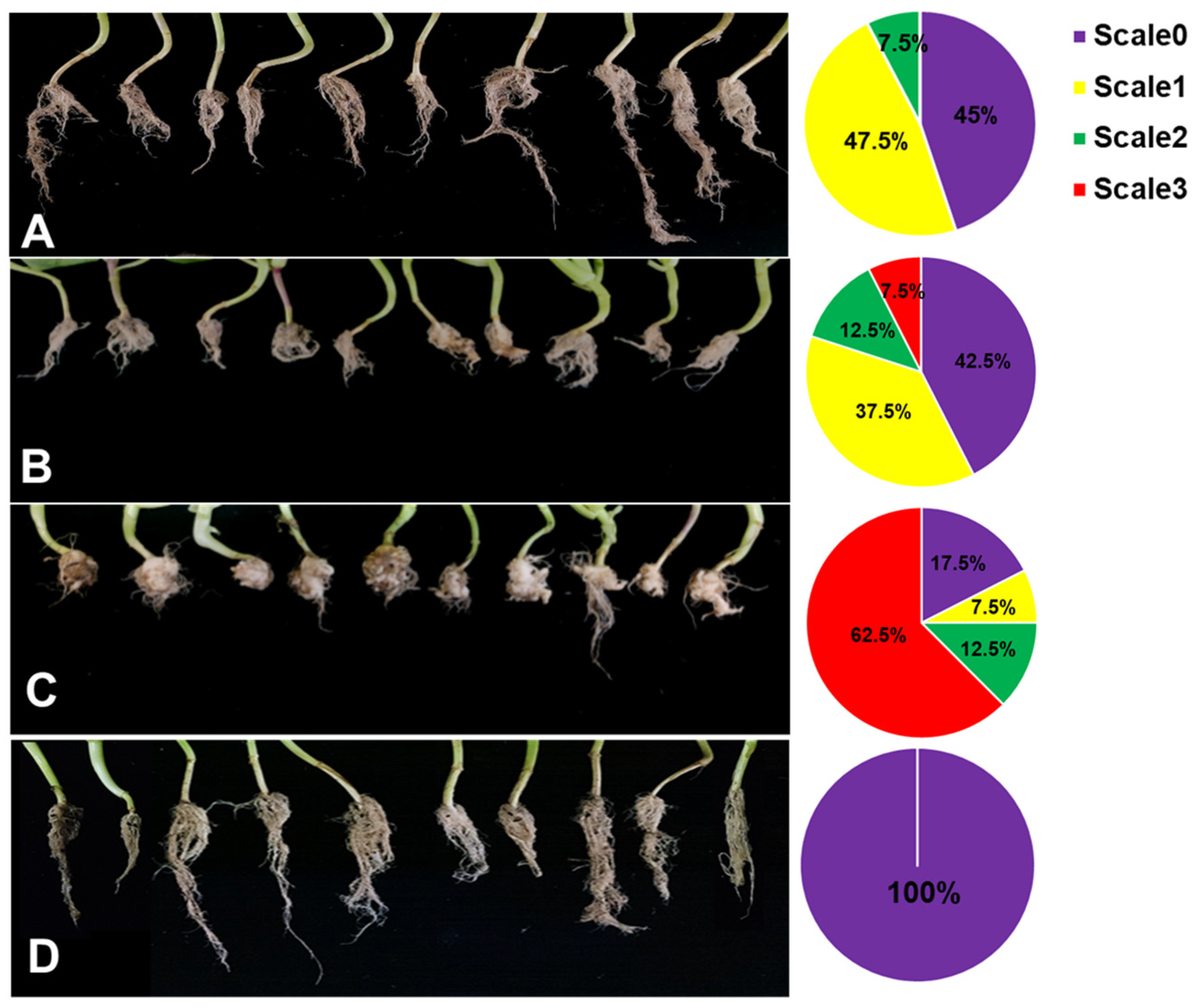
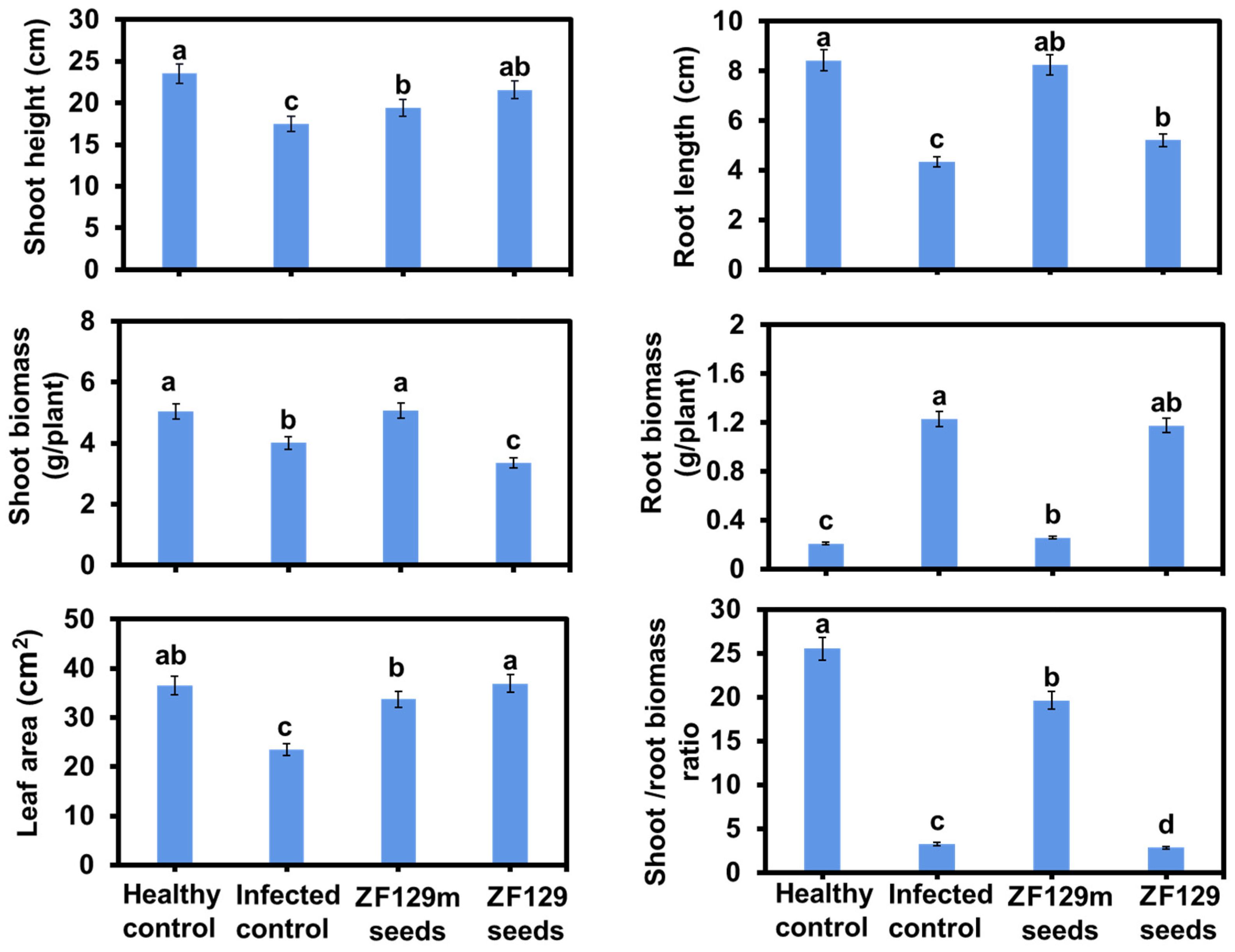
| Formula | Peat (g) | Talcum (g) | Bentonite (g) | Diatomite (g) |
|---|---|---|---|---|
| 1 | 50 | 0 | 25 | 25 |
| 2 | 24 | 0 | 0 | 76 |
| 3 | 0 | 50 | 0 | 50 |
| 4 | 23 | 25 | 32 | 20 |
| 5 | 0 | 0 | 100 | 0 |
| 6 | 21 | 0 | 35 | 44 |
| 7 | 50 | 25 | 22 | 3 |
| 8 | 0 | 25 | 75 | 0 |
| 9 | 26 | 14 | 60 | 0 |
| 10 | 0 | 1 | 23 | 76 |
| 11 | 43 | 10 | 0 | 47 |
| Formula | Single Seed Rate (%) | Abscission Rate (%) | Disintegration Rate (%) | Germination Rate (%) |
|---|---|---|---|---|
| 1 | 98.00 ± 0.50 b | 5.00 ± 0.35 f | 88.00 ± 0.15 d | 76.40 ± 2.10 c |
| 2 | 98.00 ± 0.30 b | 7.00 ± 0.25 f | 93.00 ± 0.50 bc | 56.80 ± 3.50 d |
| 3 | 80.00 ± 0.25 c | 13.00 ± 0.45 e | 74.00 ± 0.25 f | 72.70 ± 1.50 c |
| 4 | 60.00 ± 0.70 d | 50.00 ± 0.16 c | 92.00 ± 0.55 bc | 56.30 ± 2.60 d |
| 5 | 63.00 ± 0.89 d | 53.00 ± 0.18 c | 89.00 ± 0.34 c | 4.80 ± 0.50 j |
| 6 | 33.00 ± 0.56 f | 66.00 ± 0.34 b | 100 ± 0.00 a | 32.90 ± 4.20 f |
| 7 | 98.00 ± 053 b | 6.00 ± 0.26 f | 44.00 ± 0.54 e | 56.80 ± 3.10 d |
| 8 | 100 ± 0.00 a | 24.00 ± 0.56 d | 100 ± 0.00 a | 92.20 ± 1.10 b |
| 9 | 100 ± 0.00 a | 5.00 ± 0.67 f | 100 ± 0.00 a | 96.90 ± 2.90 ab |
| 0 | 57.00 ± 0.51 e | 71.00 ± 0.65 a | 97.00 ± 0.61 b | 56.70 ± 7.20 d |
| 11 | 94.00 ± 3.50 bc | 11.00 ± 0.39 e | 82.00 ± 0.57 d | 68.60 ± 5.30 cd |
| Naked seed | 98.00 ± 2.30 a |
| Inlet Temperature | Encapsulation Efficiency (%) | Bacteria Count (log CFU/g) | Spore Rate of P. polymyxa ZF129 Culture (%) | Spore Rate of P. polymyxa ZF129 Microcapsules (%) | Moisture Content (%) |
|---|---|---|---|---|---|
| 120 °C | 97.00 ± 0.58 a | 8.09 ± 0.05 a | 62.07 | 67.35 ± 0.48 c | 8.00 ± 0.02 a |
| 180 °C | 96.86 ± 0.66 b | 8.03 ± 0.08 a | 62.07 | 82.78 ± 0.59 b | 7.60 ± 0.04 b |
| 200 °C | 96.17 ± 0.49 b | 7.04 ± 0.06 b | 62.07 | 83.66 ± 0.32 a | 6.00 ± 0.05 c |
| Inlet Temperature | dv10 (µm) | dv50 (µm) | dv90 (µm) |
|---|---|---|---|
| 120 °C | 2.24 ± 0.48 c | 8.34 ± 0.56 c | 16.24 ± 0.34 b |
| 180 °C | 2.67 ± 0.11 b | 8.89 ± 0.47 b | 19.41 ± 0.22 ab |
| 200 °C | 2.94 ± 0.09 a | 10.32 ± 0.36 a | 19.61 ± 0.33 a |
| Treatment | Disease Incidence (%) | Disease Severity Index | Control Efficacy (%) |
|---|---|---|---|
| ZF129m seed | 53.2 ± 2.33 c | 21.00 ± 2.19 c | 71.23 ± 5.31 a |
| ZF129 seed | 56.83 ± 1.22 b | 28.00 ± 2.51 b | 61.64 ± 3.45 b |
| Infected control | 83.50 ± 3.12 a | 73.00 ± 3.09 a | - |
Disclaimer/Publisher’s Note: The statements, opinions and data contained in all publications are solely those of the individual author(s) and contributor(s) and not of MDPI and/or the editor(s). MDPI and/or the editor(s) disclaim responsibility for any injury to people or property resulting from any ideas, methods, instructions or products referred to in the content. |
© 2023 by the authors. Licensee MDPI, Basel, Switzerland. This article is an open access article distributed under the terms and conditions of the Creative Commons Attribution (CC BY) license (https://creativecommons.org/licenses/by/4.0/).
Share and Cite
Abdukerim, R.; Xiang, S.; Shi, Y.; Xie, X.; Li, L.; Chai, A.; Li, B.; Fan, T. Seed Pelleting with Gum Arabic-Encapsulated Biocontrol Bacteria for Effective Control of Clubroot Disease in Pak Choi. Plants 2023, 12, 3702. https://doi.org/10.3390/plants12213702
Abdukerim R, Xiang S, Shi Y, Xie X, Li L, Chai A, Li B, Fan T. Seed Pelleting with Gum Arabic-Encapsulated Biocontrol Bacteria for Effective Control of Clubroot Disease in Pak Choi. Plants. 2023; 12(21):3702. https://doi.org/10.3390/plants12213702
Chicago/Turabian StyleAbdukerim, Rizwangul, Sheng Xiang, Yanxia Shi, Xuewen Xie, Lei Li, Ali Chai, Baoju Li, and Tengfei Fan. 2023. "Seed Pelleting with Gum Arabic-Encapsulated Biocontrol Bacteria for Effective Control of Clubroot Disease in Pak Choi" Plants 12, no. 21: 3702. https://doi.org/10.3390/plants12213702
APA StyleAbdukerim, R., Xiang, S., Shi, Y., Xie, X., Li, L., Chai, A., Li, B., & Fan, T. (2023). Seed Pelleting with Gum Arabic-Encapsulated Biocontrol Bacteria for Effective Control of Clubroot Disease in Pak Choi. Plants, 12(21), 3702. https://doi.org/10.3390/plants12213702






